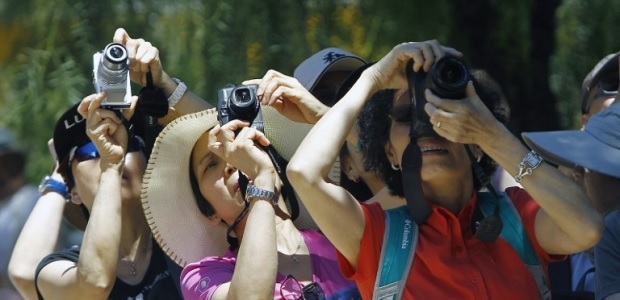BBVA uses card transactions to produce study of summer tourist spending in Spain

5.4 million anonymised overseas card transactions used to give a picture of tourist spending in Spain. Tourists spend more in Barcelona than any other Spanish destination, and more than locals in the Balearic Islands. Fashion is the biggest category for tourist spending, although American and British visitors prefer bars and restaurants.
The French, British, Germans, Dutch and Russians are the biggest summer spenders in Spain, according to a study published by the BBVA Innovation Centre in partnership with BBVA Data & Analytics. The report, which is available to view as an interactive map, used more than 5.4 million anonymised overseas card transactions from over 2 million individuals who used the BBVA Point of Sale network in July and August 2014 to produce an insight into the spending habits of visitors.
The French are the biggest spenders….but the British love the islands
According to the report,the French spent the most in Spain in summer, accounting for 18.4% of the spending and 24.2% of transactions, followed by the British (16.2% spending and 13.6% transactions), Germans (7.2% spending and 6.5% transactions), the Dutch (4.4% spending and 5.5% transactions) and Russians (7.3% spending and 5.0% transactions).
Looking at data from 11 major cities (Bilbao, Barcelona, Madrid, Sevilla, Cordoba, Granada, Malaga, Santiago de Compostela, Salamanca, Ibiza and Tenerife), the French were the largest spenders in 6 cities.
The British occupied first place in the beach resorts of Malaga,Ibiza and Tenerife, while Americans were the main visitors to Madrid and Italians to Santiago de Compostela.
The Chinese – some of the highest spending visitors – were amongst the top 5 spenders in Madrid and Barcelona. Russians – also big spenders – are ranked among the top 5 spenders in Tenerife, Costa del Sol and Barcelona.
Barcelona and Ibiza – where tourists spend the most
Looking at where tourists spend their money, Barcelona took the biggest share – 23% of total visitor spending in Spain in July and August 2014. Next was the Balearic Islands (14%), followed by Málaga (12%), Madrid (9%), Alicante (8%), Gerona (7%), Valencia (3%) and Tenerife (3%)
The report also looked at the overall contribution made to the local economy by tourist spend – the amount spent versus that spent by the Spanish. Tourists contributed more to the Ibizan economy than any other part of Spain during the summer, responsible for over two-thirds of spending (66.6%). The next largest visitor contribution was in Tenerife (38%), followed by Gerona (38%) and Malaga (35%).
The biggest single visitor spends are to be found in the North of Spain – specifically, the Guipuzcoa (193€), La Rioja (160€) and Alava (145€).
We come for the fashion
Fashion and shoes is the leading spending category for almost all nationalities (54% of Chinese nationals’ spending, 45% of Argentineans, 41% of Australians and 39% of Russians, Mexicans and Koreans)
Only two nationalities would rather hit a bar or a restaurant than a shop: Americans and Britons, who devote the highest percentage of their holiday spending to drinking and eating, 28% and 21% respectively. Austrians, on the other hand,want the best accommodation (15% of their budget).
The interactive map also contains lots of other interesting facts. For example, according to the hourly spending graphs, Italians, Americans and Finns are “night owls” of the tourist community.
Madrid, the gateway for Mexicans and Venezuelans
The maps also offer insight into interesting geographic preferences: the Camino de Santiago (Way of Saint James) is most popular among Italians, Belgians and Australians, while unsurprisingly Portuguese activity is the highest in the Spanish provinces neighbouring Portugal,. As well as the British, the Canary Islands is also popular with Venezuelans.
The map also shows how tourists travel – how Belgians and Norwegians like to plot their holiday along the Mediterranean coastline, for example. Likewise, Madrid is the focal point for the travels of Mexicans or Venezuelans around Spain, while other nationals route their itineraries through Barcelona.
The study is based on the details of transactions conducted using foreign bank cards through BBVA POS terminals during July and August 2014, which comprise a pool of data of unprecedented quality in terms of both volume and geographic detail (enabling breakdowns by city and autonomous regions).
“This initiative bears witness to our alignment with the Open Data ethos”, said Juan Murillo, Head of Urban Analysis based on data at BBVA Data & Analytics. “BBVA is one of the first financial institutions that, in an exercise in transparency, is offering society access to this type of data, in order to help public and private stakeholders improve their understanding of economic dynamics and optimize their management practices.”
Dariusz Mazurkiewicz – CEO at BLIK Polish Payment Standard
Banking 4.0 – „how was the experience for you”
„To be honest I think that Sinaia, your conference, is much better then Davos.”
Many more interesting quotes in the video below:










